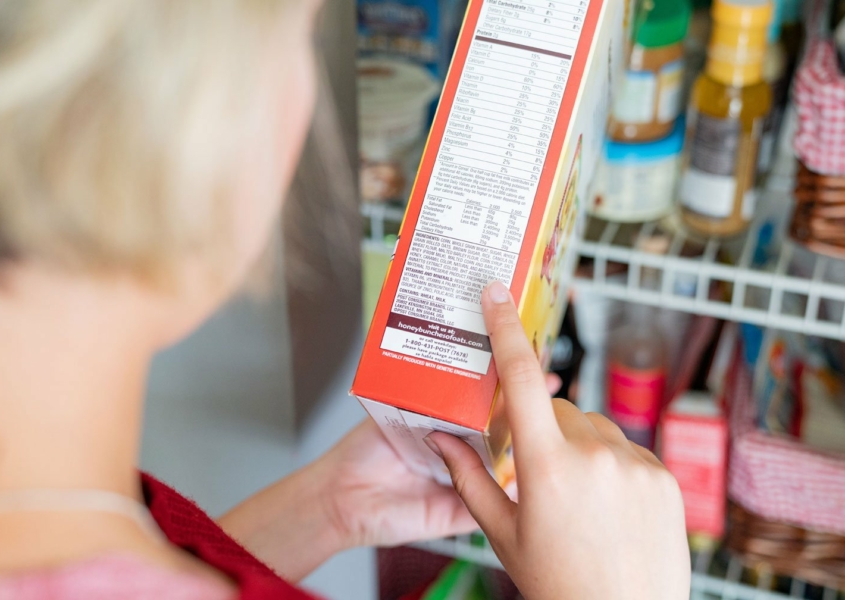How to Read Food Labels
Today, consumers are becoming more health conscious which means we are paying closer attention to what is in our food. Nutrition and ingredient information on food labels help us know exactly what is in the food product and how much, however, sometimes these labels can be deceiving or difficult to understand. As a consumer, it is important to understand how to read these labels to make the healthiest and informed decision about which food products to purchase. In this article, we will discuss the types of information that may be printed on food labels and provide tips on how to interpret that information.
Serving Size
The FDA (U.S. Food and Drug Administration) requires that a nutrition label be placed on packaged food and beverages. This label includes serving size, calorie count, total cholesterol, fat, sodium, total sugars, etc. At the very top of the label, there is a serving size (shown in the graphic below). Serving size reflects the amount that consumers typically eat or drink, so it is important to remember that it is not a recommendation for how much you should eat or drink.
It is important to note that the nutrient percentages shown on the label refer to the serving size. For example, if the label suggests that one serving of a product is 1 cup and that contains 10g of sugar, you can assume that by consuming 2 cups, you would be doubling that amount of sugar.
Percent Daily Value (%DV)
Percent Daily Value (%DV) reflects how much a nutrient in a serving of the food product contributes to a 2,000-calorie diet, which is considered standard for most adults. Even though this number is considered an average amount, some individuals may require more calories depending on their needs and lifestyle. As a general rule-of-thumb, 5% DV or less of a nutrient per serving is considered low, while 20% DV or more of a nutrient per serving is considered high, so keep this in mind when looking at a food label.
More often than not, we find that most people exceed the recommended limits for saturated fats, sodium and added sugar, which are commonly found in snack foods, frozen meals, fast food and beverages like soda and juice. Many people do not get the recommended amount of essential nutrients like potassium, dietary fiber, calcium and other vitamins- so be sure to do your research to find which foods at the super market are most nutrient-dense (think fresh produce and high-quality protein sources).
Product Dates
There are two types of product dates commonly printed on packaged food and beverages:
· “Sell by” is labeled at retailers, and informs them of the day by which the food or beverage product should be sold or removed from the shelves. However, this does not mean that the product is unsafe to consume after that date. Usually about one-third of a product’s shelf-life remains after the sell by date for the consumer.
· “Use by” indicates how long food and beverage items will be at peak quality. This means if you use or consume the products after the provided date, the product may have changed in appearance, texture, flavor and quality. Expired foods, especially items like produce, meat or dairy products should not be consumed past the listed use by date.
When buying items from the grocery store, it’s important to look at the expiration dates listed on the products you purchase so you make sure you are buying a fresh product. Also avoid any items that are severely dented, leaking at the seams, or have any holes or visible damage.
Reading the Ingredient List
The ingredients in packaged food items are most often listed separately from the Nutrition Facts info, and includes each ingredient in the product in order of quantity. For example, the ingredient with the highest concentration will be listed first. Many health experts suggest that the first three ingredients in a food product are the most crucial to pay attention to- if those include refined grains, a type of sugar or hydrogenated oils, those are best avoided or should at least be consumed in small amounts. Experts also suggest sticking to foods with ingredients that you can recognize and have a fairly short list of ingredients.
It is also important to be mindful of terminology that food companies use to market their products, that may be deceiving to what the product actually contains. Food and beverage items may include terms like “light”, “reduced sugar”, “low calorie”, “fat free”, etc. None of this is necessarily bad, but it can often mean that by omitting one ingredient, they are adding in other additive ingredients or chemicals to compensate that are even worse for your health. For example, diet soda is marketed to the consumer as being healthier than the regular real sugar alternative, but it does contain artificial ingredients and sweeteners that are made from unnatural chemicals. In summary, just because something claims to be healthier on the package, does not always mean that it is. Do not let the claims on the package fool you!
In conclusion, the best way to avoid being misled by product labels is to try to avoid processed foods whenever possible. If you do buy packaged foods, use your knowledge of reading the Nutrition Facts and Ingredient label to sort out the junk from high-quality products.



